#HumanCreativity
Explore tagged Tumblr posts
Text

US Appeals Court Rules AI-Generated Art Ineligible for Copyright Without Human Creator
A U.S. federal appeals court has ruled that AI-generated art without human involvement cannot be copyrighted. The decision upholds the U.S. Copyright Office’s rejection of Stephen Thaler’s attempt to secure copyright for an image created by his AI system, DABUS. The court reaffirmed that only works with human authors qualify for copyright protection. Thaler plans to appeal, arguing the ruling hinders AI innovation, while the Copyright Office maintains that human authorship is a fundamental copyright requirement.
Contact Us
DC: +1 (202) 666-8377 MD: +1 (240) 477-6361 FL +1 (239) 292–6789 Website: https://www.ipconsultinggroups.com/ Mail: [email protected] Headquarters: 9009 Shady Grove Ct. Gaithersburg, MD 20877 Branch Office: 7734 16th St, NW Washington DC 20012 Branch Office: Vanderbilt Dr, Bonita Spring, FL 34134
0 notes
Photo
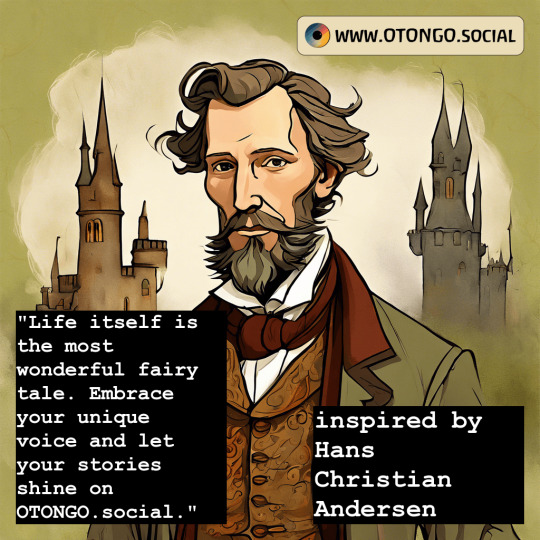
Hans Christian Andersen was a Danish author celebrated for his fairy tales that captivated audiences of all ages, encompassing themes of love, adventure, and the beauty of life.. Get motivated to create content with www.OTONGO.social -> waitlist open.
#Storytelling#ContentCreation#Authenticity#VoiceYourVision#OTONGOSocial#HumanCreativity#Photography#SocialMedia#LinkYourStory#RealImages#BrandIdentity#CreativeCommunity#InspireOthers#GenuineContent#Innovate#JoinTheWaitlist#BeHeard#CreateWithUs#VoiceNarratives#EngageCreatively
0 notes
Text
Could AI Tools Like Genie Fully Replace Human Developers?

Imagine a future where AI tools like Genie by Cosine handle every aspect of software development. Could AI fully replace human developers, or is there still a need for human intuition, creativity, and oversight in software engineering?
Scenario: Consider a scenario where AI-driven models like Genie can autonomously create, debug, and optimize software. Developers would no longer need to write code manually, as AI tools handle everything from prototyping to full application development. Human involvement would shift from hands-on coding to guiding AI, reviewing its work, and focusing on creative aspects such as conceptualizing new solutions and features.
Analysis:
Potential Benefits:
Faster Development Cycles: AI-driven software engineering would enable rapid development cycles, reducing the time to market for applications.
Cost Savings: Automation of the coding process could significantly reduce the costs associated with hiring large development teams.
Challenges:
Creativity and Contextual Understanding: Human developers bring creativity, intuition, and contextual understanding that AI may struggle to replicate. Can AI-generated software be truly innovative without human guidance?
Ethical and Security Concerns: AI-generated code may introduce new vulnerabilities or fail to consider ethical implications. Would human oversight still be necessary to ensure safe and ethical software development?
Do you think AI tools like Genie by Cosine could fully replace human developers, or is there always a need for human creativity and oversight in software engineering? Would you trust an AI-driven development process entirely? Share your thoughts!
Join the conversation on the future of software development. Could AI replace human developers, or will human insight always be irreplaceable?
Share your views and explore more at aiwikiweb.com/product/cosine-ai/
#GenieAI#Cosine#FutureOfSoftware#HumanVsAI#AIinDevelopment#TechDiscussion#AIEngineering#CodeAutomation#HumanCreativity#TechInnovation
0 notes
Text
The Intersection of AI and Human Creativity: Can Machines Innovate?
Artificial Intelligence (AI) has become one of the most transformative technologies of the 21st century, influencing everything from healthcare and finance to entertainment and manufacturing. But as AI continues to evolve, one of the most intriguing questions being asked is whether machines can truly innovate and be creative. Creativity, often seen as a uniquely human trait, involves the ability to generate original ideas, think outside the box, and push the boundaries of knowledge and culture. The concept of machines, driven by algorithms and data, being able to perform these tasks challenges traditional notions of creativity. Yet, as we delve deeper into the capabilities of AI, the line between human creativity and machine-driven innovation is becoming increasingly blurred. This raises important questions about the nature of creativity, the role of AI in fostering new ideas, and the potential collaboration between humans and machines in the creative process.
AI has already made significant strides in creative fields, from generating music and art to writing poetry and developing marketing strategies. For instance, AI-powered systems like OpenAI’s GPT series can write coherent and sophisticated essays, stories, and poems. Google’s DeepMind has created AI systems that can generate entirely new musical compositions. In visual arts, programs like DALL·E, a neural network developed by OpenAI, can create original images based on textual descriptions. These achievements, while impressive, prompt us to ask: Are these examples of true innovation, or are they merely the result of complex algorithms synthesizing vast amounts of existing data?
To understand whether AI can truly innovate, we first need to examine what innovation means. At its core, innovation is about creating something new, whether it’s a novel idea, a unique product, or an inventive solution to a problem. Human creativity draws from emotion, intuition, and lived experiences, often involving a deep understanding of the nuances of culture, society, and individual perspective. On the other hand, AI, as it exists today, functions based on patterns and data that it is trained on. It analyzes enormous datasets, recognizes patterns, and generates outputs that are novel but typically derived from existing information. In this sense, AI’s creativity is more about recombination than true innovation—it excels at blending and remixing existing ideas rather than originating something entirely new.
A key aspect of human creativity is the ability to draw from seemingly unrelated fields to solve complex problems in innovative ways. For example, Leonardo da Vinci’s deep knowledge of both art and science allowed him to create inventions far ahead of his time. Can AI achieve this level of interdisciplinary thinking? While AI can certainly process and analyze information from multiple domains, it lacks the personal, emotional, and experiential knowledge that often drives humans to make creative leaps. This limitation raises questions about whether AI can ever truly match the creativity of the human mind.
However, it would be shortsighted to dismiss AI’s role in the creative process. In many ways, AI acts as a powerful tool that can enhance human creativity. Instead of viewing AI as a competitor to human innovation, we should consider it a collaborator. By automating repetitive tasks, generating ideas, and analyzing vast amounts of information quickly, AI can free up humans to focus on more abstract, conceptual, and emotionally driven aspects of creativity. For example, AI can help a musician experiment with different sound patterns or assist a designer in exploring new visual styles. In these cases, AI isn’t replacing human creativity but augmenting it, enabling artists, writers, and creators to push their boundaries further than they might have on their own.
Yet, there remains a lingering question: Can AI ever reach a point where it can independently innovate without human input? Some researchers believe that as AI continues to evolve, it may develop more sophisticated forms of intelligence that allow for greater autonomy in the creative process. With the development of neural networks that mimic the human brain and advances in machine learning, there’s potential for AI to learn in ways that more closely resemble human cognitive processes. However, even the most advanced AI systems are still far from replicating the full depth and complexity of human thought, emotion, and intuition. Without these qualities, true innovation, as humans understand it, may remain elusive for AI.
Conclusion:
AI has shown remarkable potential in areas traditionally dominated by human creativity, it is not yet capable of true innovation in the way humans understand it. AI can analyze data, recognize patterns, and generate novel combinations of existing ideas, but it lacks the personal experience, intuition, and emotional depth that drive human creativity. However, this doesn’t mean that AI doesn’t have a place in the creative process. Instead, AI should be seen as a powerful tool that enhances human creativity, enabling creators to explore new possibilities and push their boundaries. As AI technology continues to evolve, the collaboration between humans and machines may lead to a new era of innovation, where the strengths of both are combined to create something truly extraordinary.
#ai#humancreativity#artificialintelligence#machinelearning#innovation#creativity#technology#futureofwork#aiinnovation#aiandcreativity
0 notes
Text
AI content is a trap
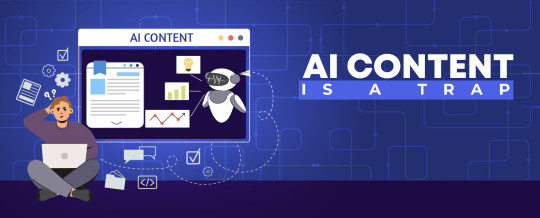
Introduction
When it comes to creating content, businesses, and individuals are heavily depending on AI tools these days.
All due to the machine-based intelligence that AI tools use, making them more susceptible to committing mistakes and errors when generating content for their users.
The most dreadful part is that AI tools often end up plagiarizing your content, further degrading their quality with unwanted syntax errors and grammatical pitfalls.
As a result, users unconsciously get entangled in some real-world traps that not only affect their online presence but also harm their reputation in the market.
Here is how!
Key Insights
Warning signs of AI-generated content
4 potential traps to avoid in AI content generation
When to use AI for content generation
FAQs
Conclusion
Negative impact of relying on AI content
AI algorithms are trained to mimic existing patterns in a content piece. Hence the AI-generated content turns out to be generic, low quality, and factually correct. This not only will dissatisfy your readers but also upset the Search Engines that prioritize fresh and unique content helpful to their readers. You will lose engagement as well as higher rankings on the Search Engine Results Page.
Warning signs of AI-generated content
AI tools such as Jasper, ChatGPT, Gemini, WordTune, etc. have made content generation much easier and quicker than before.
While many of these tools help produce relevant content, others often bring lousy outputs to the table.
Here are some of the signs that show that the content is AI-generated and not written by a human.
You will see Bold almost everywhere
So, recently you have read an article or blog, where almost all the keywords are seen in bold. Be assured that it has been written by an AI tool as it loves to use the Bold feature frequently.
Repetitive Lingo and Keyword Stuffing
Repetition of the same language and keyword stuffing is a clear indicator that the content is AI-generated all due to the machine-based intelligence that it follows.
Overdramatic
If you notice the use of too many fancy words with an overdramatic tone in the content, be certain that it is AI-generated with a lack of crucial information for the readers.
Lack of Originality and Depth
A lack of depth and originality with too many fancy and flowery words, that's how perfect AI content will look like. And, it's all due to the way AI tools have been trained to create content.
Why AI content is a trap?
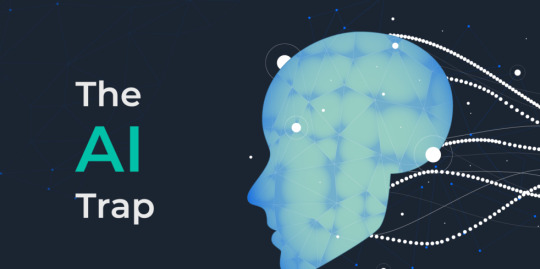
Google prioritizes human experience in content because humans engage more with human-like content that showcases unique voices, emotions, and personal touch while interacting with readers.
However AI content lacks emotion, human perspectives, storytelling approach, and uniqueness. This is why readers don't prefer to engage with your content as it doesn't resonate with a human's pain points and feelings. As a result, Google also downranks the content on their search rankings, causing you to lose both conversion and ranking.
4 potential traps to avoid in AI content generation
Too much use of AI tools can pose serious threats to your brand and you as a distinct entity. Below are 4 potential traps to avoid when using AI tools for content creation.
Trap 1
Using AI tools to research, organize, and develop notes for reporting or storytelling is good as they compile data quickly and easily. But, with it comes the risk of missing out on real-time resources. This may affect your write-ups with unwanted plagiarism issues or bugs.
Trap 2
When pasting AI tools as a reference with your content, make your viewers see the difference between the two write-ups. Failing to do so will give them the impression that the entire piece is AI-generated, ultimately harming your brand.
Trap 3
AI-generated content cannot detect the sources of the original writeups, so, consequently, plagiarize them with incorrect information. This negatively impacts your online presence.
Trap 4
AI-generated content is mostly false, incorrect, and unreliable with too many bugs and mistakes in the whole piece. So, think before you invest.
The value of human-written content
Humans can mix their own experiences with emotion to prepare a content piece, that resonates well with readers, not bots.
Human storytelling approaches, along with emotional appeal, connect directly with readers.
Humans write content that seamlessly reflects brand identity and the brand's unique voice.
When readers engage with your content more, Search Engines also boost your search rankings.
When to use AI for content generation?
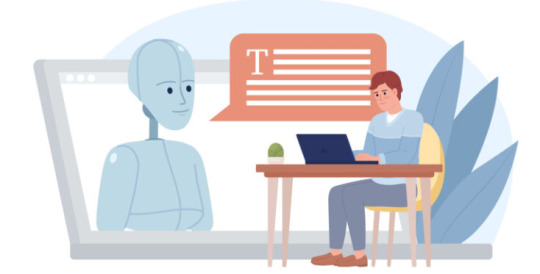
AI tools like ChatGPT, Jasper, or Gemini can be the most useful when:
You have already earned a brand reputation and tone of voice: Your content must be the reflection of your brand identity with a distinct tone and voice that enables effective storytelling. So, use AI tools to create content only after you have gained a substantial reputation in the market.
You are aware of what to ask: Sometimes, AI tools can give lousy outputs while at other times outstanding results. In short, these tools are very unpredictable. So, use them only when you are certain of what message to be conveyed to your target audience.
You know your niche clearly: When using AI tools to gain knowledge in your relevant sector, be a little careful as they tend to make unwanted mistakes and mostly use outdated resources. So, once you know your niche, you can easily correct these bugs and pitfalls, and post contents that capture your audience’s attention faster than expected.
So, the bottom line is AI tools still have a long way to go when it comes to replacing human writers for effective content creation. If you are reading this blog, probably you are in search of genuine content providers. If you agree with me that AI content will sabotage your website, you can contact us, a reputed digital marketing agency in Kolkata to learn more about our services.
FAQs
1. Is AI-generated content bad?
AI-generated content often looks very similar to the already existing content on the web with the additional risk of plagiarism. AI algorithms optimize and copy the existing data as identically as possible. So, if you use AI-generated content frequently, you have a greater risk of getting affected by unwanted plagiarism issues.
2. Can AI-generated content affect SEO?
No, but rather AI-generated content can positively impact your SEO score as long as you know how to use these tools in the best of your favor. In fact, Artificial Intelligence has redefined the way viewers see content as sources of information as they accelerate the digital journey of every B2B and B2C Company to its next level.
3. Does Google hate AI content?
The simple answer is no. As long as you can create good-quality content that caters to their search quality rater guidelines, Google won’t mind whether they are AI-generated or human-made content. However, Google uses tools that can detect malicious or low-quality outputs automatically, but the good news is it does not purposely avoid all the blogs and articles that are AI-enabled.
Conclusion
Everything comes with its fair share of advantages and disadvantages, so AI-generated content cannot be an exception. Such content is good until you know your niche, can use the tools effectively, and have the ability to fix the necessary bugs and mistakes as and when required.
So, make sure that you stay away from the 4 detrimental traps at all costs to avoid being termed as an AI-generated content creator. Not only do AI contents lack the necessary information, insights, and quotes but they also provide false information that can mislead your viewers and prevent them from making informed decisions.
Therefore, use AI tools for content generation for content generation only when it is absolutely necessary.
Good Luck!
#AIWriting#ContentMarketing#AIResponsibility#BeAContentCreator#NoShortcuts#VerifyYourSources#AuthenticContent#BuildTrust#AIbias#ChallengeTheAlgorithm#TheFutureIsHuman#HumanCreativity#ContentStrategy#ConnectWithYourAudience
1 note
·
View note
Text

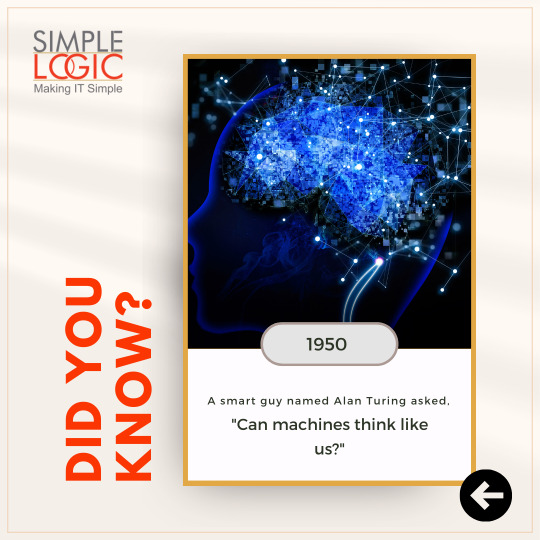



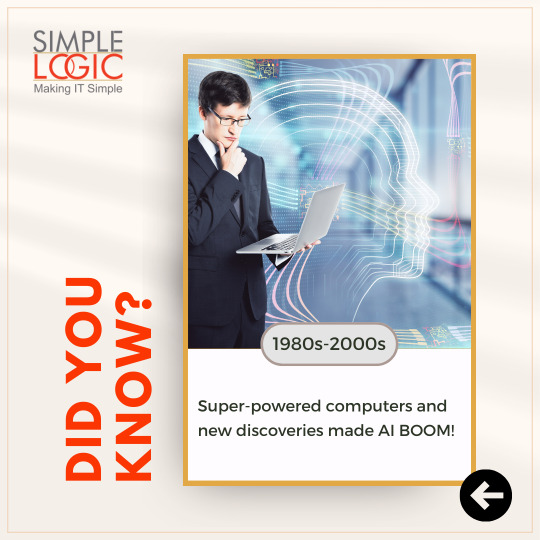



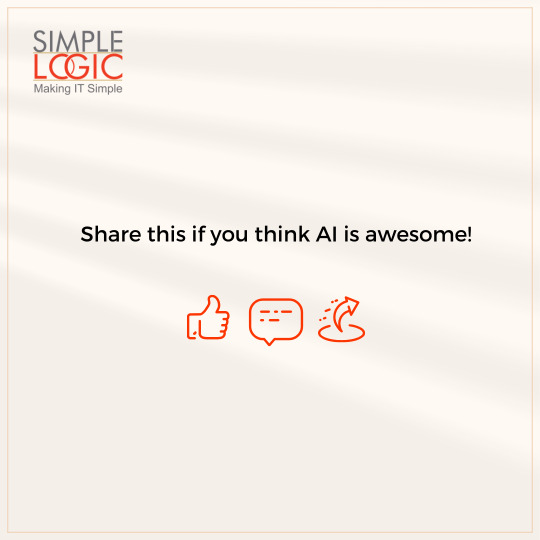
#DidYouKnow Dive into the AI Journey!🚀 Swipe left to trace the evolution of Artificial Intelligence🕵️♂️
Share the AI love if you find this journey fascinating! 🌐
#artificialintelligence#intelligence#artificial#humancreation#artificialsunflower#artificialgods#human#knowledge#artificialflowersbouquet#datascience#intelligent#technologysolutions#technology#machinelearning#aihistory#aijourney#ai
0 notes
Photo

Feeling and longing are the motive forces behind all human endeavor and human creations. Feeling Longing MotiveForces HumanEndeavor HumanCreations Inspiration Emotions Drive Creativity Passion Existence Motivation Soulful HumanExperience Philosophy Wisdom InnerStrength
0 notes
Text

little christmas post, which is absolutely not christmas themed
(was my entry for a dtiys by humancreates a few years ago on ig ☆)
hope u all have a nice christmas/some relaxing days :3
68 notes
·
View notes
Text
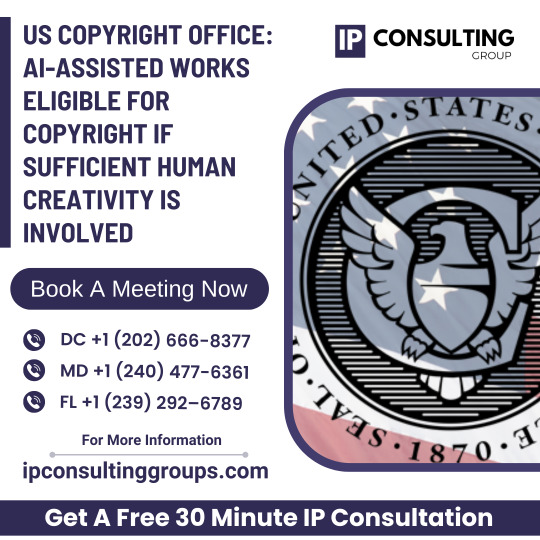
US Copyright Office: AI-Assisted Works Eligible for Copyright If Sufficient Human Creativity Is Involved
The U.S. Copyright Office has clarified that artists can copyright works created with AI assistance, as long as human creativity plays a central role. The report reinforces that fully AI-generated content is not eligible for copyright, and merely prompting an AI tool does not grant ownership. However, it does not address the ongoing legal disputes over AI training on copyrighted works. The office is preparing a separate report to explore licensing, liability, and AI model training on copyrighted content.
Contact Us
DC: +1 (202) 666-8377 MD: +1 (240) 477-6361 FL +1 (239) 292–6789 Website: https://www.ipconsultinggroups.com/ Mail: [email protected] Headquarters: 9009 Shady Grove Ct. Gaithersburg, MD 20877 Branch Office: 7734 16th St, NW Washington DC 20012 Branch Office: Vanderbilt Dr, Bonita Spring, FL 34134
#ipconsultinggroup#AICopyright#USCopyrightOffice#AIandCreativity#IntellectualProperty#CopyrightLaw#AIRegulations#CreativeRights#HumanCreativity#AIAssistedWorks#CopyrightProtection
0 notes
Photo

Immanuel Kant was a central figure in modern philosophy, known for his work on ethics and metaphysics, emphasizing reason and the human experience.. Get motivated to create content with www.OTONGO.social -> waitlist open.
#OTONGOSocial#ContentCreation#AuthenticVoice#CreativeCommunity#SocialMedia#VoiceOverContent#JoinTheWaitlist#HumanCreativity#Photography#SocialNetworking#ContentAuthenticity#OriginalityMatters#BrandIdentity#AIvsHuman#StayCreative#EmbraceTheReal#VoiceYourThoughts#CaptureTheMoment#AuthenticContent#JoinUsNow
0 notes
Video
youtube
Mukjizat Numerik Pola 237: Simetri dan Keseimbangan Ilahi dalam Al-Quran
Discover the divine wisdom of the Al-Quran as a source of light, guiding us toward truth and goodness. This video delves into the significance of knowledge, observation, and reflection, emphasizing insights from Surah Al-Baqarah. We'll explore how the universe operates under divine laws, encouraging appreciation and understanding of Allah's greatness through cosmic phenomena and human life.
Join us as we uncover the meticulous design of human creation, the engineering marvel of the human body, and the ordered movement of celestial bodies. Reflect on the miracles of the heavens and the grand design of creation inspired by the Al-Quran.
#DivineWisdom #QuranicScience #MiraclesOfCreation #IslamicKnowledge #SurahAlBaqarah #CosmicOrder #HumanCreation
If you find this video insightful, please like and share it!
OUTLINE:
00:00:00 Mukjizat Numerik Pola 237: Simetri dan Keseimbangan Ilahi dalam Al-Quran 00:15:06 Divine Order: Menjelajah Kebijaksanaan Al-Quran Melalui Alam dan Matematik 01:02:55 The Eternal Guidance of the Quran 01:07:58 Evidence of Divine Order 01:13:37 Celestial Mechanics and Divine Precision
0 notes
Text
AI vs. Human Creativity: Where Do We Draw the Line?
Can AI truly replace human creativity, or is the future about collaboration? Dive into our latest post, AI vs. Human Creativity: Where Do We Draw the Line?, to explore how technology enhances—but doesn’t replace—our ability to connect, create, and innovate. 🌟 #AIinMarketing #HumanCreativity #AICollaboration #MarketingInnovation”
Where AI Meets Human Creativity: A Collaboration of Technology and Imagination to Shape the Future of Marketing and Innovation. The rise of AI tools in marketing and content creation has sparked an ongoing debate: Can machines truly replace human creativity? While AI excels at speed, precision, and scalability, creativity—the art of connecting emotionally and thinking outside the box—remains…

View On WordPress
#AI Chatbot#AI Content Creation#AI for Email Marketing#AI for Freelancers#AI for Marketing#AI for Non-Techies#AI for Saving Time#AI for Small Business Owners#AI in Social Media Marketing#AI Marketing Essentials#AI Marketing for Beginners#AI Marketing Tips#AI Marketing Trends#AI Productivity Tools#AI SEO Strategies#AI Simplified for Beginners#AI Social Media Strategies#AI Tools for Everyone#AI Tools for Marketing#AI-Driven Analytics#AI-Generated Content#AI-Powered Campaigns#AI-Powered Success#Beginner Marketing Tips#Beginner’s Guide to AI#Boost Marketing with AI#Content Marketing#Content Marketing with AI#Digital Marketing#Digital Marketing with AI
0 notes
Text
Could Advanced AI Assistants Like Claude Replace Human Problem Solvers?
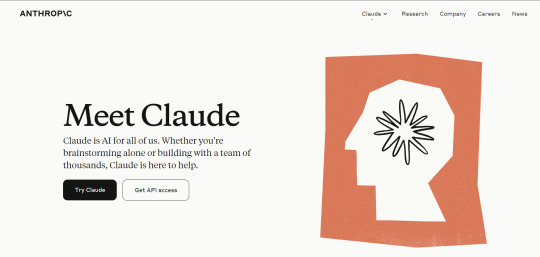
Imagine a future where AI models like Claude handle all problem-solving tasks in both technical and creative domains. Could AI fully replace human problem solvers, or is there still a role for human intuition and creativity?
Scenario: Consider a future where AI assistants like Claude handle every aspect of problem-solving, from debugging code to interpreting data and making business decisions. The AI provides reliable, fast, and accurate solutions, reducing the need for human intervention. This could lead to highly efficient business environments, but raises questions about the value of human intuition.
Analysis:
Potential Benefits:
Efficiency Gains: AI like Claude can provide rapid solutions and handle complex tasks, eliminating delays due to human limitations.
Cost Reduction: Automating problem-solving processes reduces the cost of human labor and accelerates project timelines.
Challenges:
Loss of Human Creativity: Problem-solving is not just about reaching a solution; it involves creativity, empathy, and the ability to think outside the box. Can AI match the level of insight that human problem solvers bring?
Ethical Concerns: Relying entirely on AI for problem-solving raises ethical questions about accountability, especially in high-stakes decisions where the impact is significant.
Engagement:
Question to Audience: Do you think AI assistants like Claude could replace human problem solvers entirely, or is there still a crucial need for human intuition and creativity? Would you trust AI to solve all your complex challenges? Share your thoughts!
Join the discussion on the future of problem-solving. Could AI be the answer, or will human insight always play a vital role? Share your views and learn more about Claude at aiwikiweb.com/product/claude/
#AIProblemSolving#Claude#FutureOfWork#AIvsHuman#HumanCreativity#AdvancedAI#TechDiscussion#BusinessSolutions#AIinBusiness#Anthropic
0 notes
Text
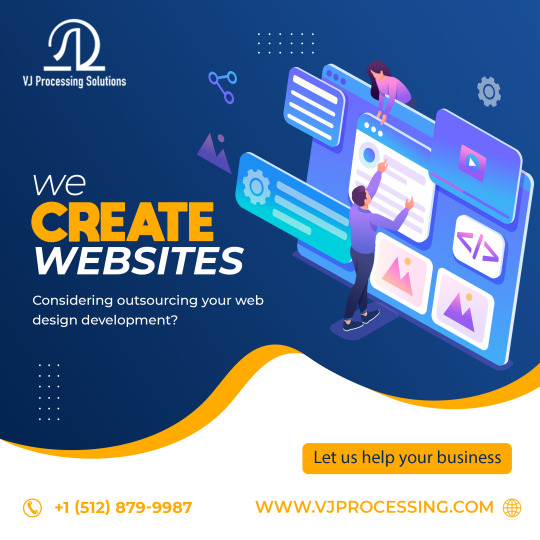
Ready to elevate your online presence? We're here to make your web design dreams a reality! Connect VJ Processing Solutions
. . . #HumanCreativity #CraftedWithCare #DesignersMagic #HumanTouchDesign #CreativityUnleashed #HumanDesignMagic #DesignersAtWork #WebDesignPros #WebDevelopment #OutsourceWebDesign #WebsiteCreation #WebDesignExperts #OnlinePresence
0 notes
Text
👀 Looking for a #GameChanging solution for your content creation needs? __ 💡 Check #ChatGPT#Marketplace 🏦, where #AI ���🤖 meets #HumanCreativity 😀.
Why? - #Efficiency - #Customization - #Affordability - #Quality
Overall, the #ChatGPTMarketplace is changing the game for #ContentCreation by providing a faster, more affordable, and more customizable solution that leverages the #power of AI.
#contentmarketing#AI#CHATGPT#artificialintelligence#enhancedintelligence#digitalera#algorithm#NLP#naturallanguageprocessing#commercialexcellencebulletin
0 notes